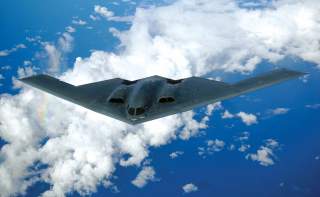China Is Building Its Very Own Stealth Bombers: Meet the H-20 and JH-XX
Meet the H-20 and JH-XX
Key Problem: China remains reliant on foreign-sourced components for high-performance aircraft engines.
China is developing not one but two new stealth bombers, the U.S. Defense Intelligence Agency claimed in a January 2019 report.
While the People's Liberation Army has not been shy about discussing the H-20 strategic bomber that the Xian Aircraft Industrial Corporation is developing for the PLA Air Force, there are many fewer public references to the other stealth bomber, which apparently carries the designation JH-XX.
If the report is accurate and China completes development of the JH-XX, the Chinese air force could become the first air arm in the world to deploy a radar-evading fighter-bomber whose main mission is long-range ground-attack.
Other stealth fighter types, including the U.S. military's F-22 and F-35, the Russian air force's Su-57 and the PLAAF's J-20 and J-31 either primarily are air-to-air fighters or combine air-combat capability with the ability to strike ground targets.
Beijing’s goal of eventually forcing Taiwan to unify with China has driven the new bombers' development. "Beijing’s anticipation that foreign forces would intervene in a Taiwan scenario led the PLA to develop a range of systems to deter and deny foreign regional force projection," the DIA reported.
The Pentagon's air base at Guam, a key staging area for U.S. warplanes operating over the Western Pacific, is a major potential target of China's new bombers.
"The PLAAF is developing new medium- and long-range stealth bombers to strike regional and global targets," the DIA continued in its report. "Stealth technology continues to play a key role in the development of these new bombers, which probably will reach initial operational capability no sooner than 2025.
"These new bombers will have additional capabilities, with full-spectrum upgrades compared with current operational bomber fleets, and will employ many fifth-generation fighter technologies in their design."
In service, the JH-XX could complement or replace existing JH-7 fighter-bombers while the larger H-20, which could be similar in size and capability to the U.S. Air Force's own B-2 stealth bomber, flies alongside the PLAAF's new H-6K bombers.
The H-6K is a heavily-upgraded version of the Soviet Tu-16 bomber that first flew in 1952. "The H-6K variant, which China is fielding in greater numbers, integrates standoff weapons and features more efficient turbofan engines in redesigned wing roots," according to the DIA.
It's a carrier aircraft for the new CJ-20 land-attack cruise missile that's similar to America's Tomahawk missile. "This extended-range aircraft can carry six LACMs, providing the PLA a long-range, standoff, precision-strike capability that can reach Guam."
An H-6 reportedly can carry a heavy payload out to a distance of a thousand miles. A JH-7 reportedly can travel as far as 560 miles. It's unclear how far the H-20 and JH-XX might range.
But as the Chinese air force reequips with new, medium- and long-range bombers, it also has been expanding the geographical area across which the bombers operate, sending more aircraft beyond the "first island chain" that runs from Russia's Kuril Islands south to Japan and then on to The Philippines.
"In 2015 the PLA Air Force carried out four exercise training missions past the first island chain through the Bashi Channel, the northernmost passage of the Luzon Strait and through the Miyako Strait closer to Japan," the DIA explained.
"The Miyako Strait flights were 1,500 kilometers from Guam, within range of the PLAAF’s CJ-20 air-launched land-attack cruise missile. Also in 2015, the PLAAF began flying the H-6K medium-range bomber, the PLAAF’s first aircraft capable of conducting strikes on Guam (with air-launched LACMs like the CJ-20), past the first island chain into the Western Pacific."
The new bombers also could carry nuclear weapons. "As of 2017, the [Chinese] air force had been reassigned a nuclear mission, probably with a developmental strategic bomber," the DIA reported. "The bomber’s deployment would provide China with its first credible nuclear triad of delivery systems dispersed across land, sea, and air—a posture considered since the Cold War to improve survivability and strategic deterrence."
It's unclear whether the JH-XX also might carry nukes. That the JH-XX is a fighter-bomber, rather than a multi-role fighter, implies that it's design emphasizes range and payload over maneuverability.
If there's one thing that might hold back the JH-XX's development, it's the new plane's engine. Problems integrating a Chinese-built engine reportedly have slowed development of the PLAAF's J-20 fighter.
"China’s aviation industry has advanced to produce a developmental large transport aircraft, modern fourth- to fifth-generation fighters incorporating low-observable technologies, modern reconnaissance and attack UAVs and attack helicopters," the DIA explained in its report.
"However, China’s aircraft industry remains reliant on foreign-sourced components for dependable, proven, high-performance aircraft engines."
David Axe serves as the new Defense Editor of the National Interest. He is the author of the graphic novels War Fix, War Is Boring and Machete Squad. This first appeared earlier in the year.
Image: Flickr.

